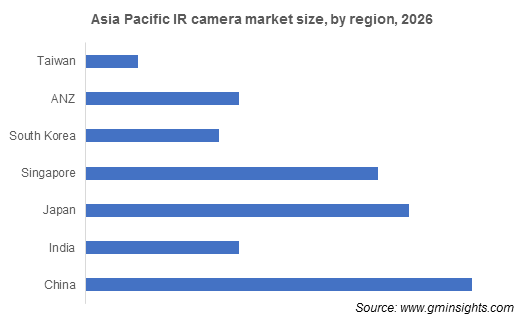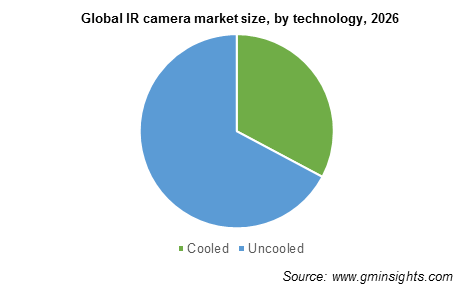Home > Media & Technology > Security and Surveillance > Physical Security > Infrared Camera Market
Infrared Camera Market Analysis
- Report ID: GMI397
- Published Date: Jan 2020
- Report Format: PDF
Infrared Camera Market Analysis
Fixed infrared cameras accounted for over 40% of the U.S. industry share in 2019 and is expected to increase its market size during the next few years. Monitoring & surveillance of airport perimeters is a key challenge for numerous local, state, and federal agencies. Infrared camera industry players are developing the cameras to enhance the signal to noise ratio, offer a higher processing capability & better range, and reduce false alarms.
These are deployed at a specific height and distance to provide 360-degree coverage. Fixed short-range infrared cameras with long-range surveillance capability are used in airport perimeter security to ensure zero gaps in the perimeter coverage. The other market segments by product type include handheld and Pan-Tilt-Zoom (PTZ).
The LWIR camera segment will witness high growth due to its ability to operate efficiently in harsh environments such as smoke or aerosol. These cameras are much efficient in detecting objects, which span a very wide temperature range requiring intra-scene imaging of both hot & cold objects. The cameras are widely adopted for long-range surveillance due to their long-range FOV. Furthermore, LWIR-enabled technology cameras are used for military & firefighting applications.
The uncooled infrared camera market will witness steady growth, as the cameras are cheap and require lower maintenance due to absence of cryogenic cooling units. The availability of low-cost uncooled infrared detectors from suppliers and enhanced manufacturability contribute to development of cheap uncooled cameras. Low-cost, easy integration with any security system, and lower maintenance cost are driving the adoption of cameras in surveillance systems in various end-use industries.
In the automotive application, integration of infrared cameras with ADAS will enhance night-vision capabilities and improve passenger safety. Market players are focusing on strategic alliances to integrate the equipment with ADAS. For instance, in October 2019, FLIR Systems, Inc. partnered with Veoneer to integrate the equipment into ADAS of a level-4 AVs for a global automaker. The deployment of these cameras in automobiles will aid in the detection of pedestrians, reducing road accidents and mishaps.
OEMs are rapidly adopting the equipment and integrating them into self-driving software of Autonomous Vehicles (AVs) due to its low-cost, easy integration capabilities, and the ability to offer enhanced all-weather vision (including night-vision). Industry players are developing automotive-specific cameras to increase their market share.
For instance, in May 2019, FLIR Systems, Inc. launched FLIR Automotive Development Kit (ADK) for AVs. The kit is compatible with auto ware, an open-source software for self-driving vehicles. This will help OEMs to train their self-driving software at a comparatively lower cost.

Asia Pacific infrared camera market will expand at around 10.5% CAGR during the forecast timeline due to rise in military spending. According to SIPRI, in 2018, military spending in Asia Pacific was USD 507 billion and accounted for 28% of global military spending. The countries present in the region are spending a substantial amount of their budget on deploying high-security surveillance cameras to track down criminals, improve traffic surveillance, and deploy in big infrastructure projects. For instance, Wuhan Guide Infrared Co., Ltd. provides infrared cameras to the government of China.
The China market is majorly concentrated in Southern China as it helps manufacturers to avail IR LEDs at a cheaper price. Hong Kong, a technology hub, is easily accessible from Southern China, which will benefit manufacturers by reducing their operational expenses. This offers Southern China manufacturers an edge over Eastern and Northern China.
Key market players in the region are focusing on strategic alliances with end-use firms to increase their presence in a specific sector. For instance, in September 2019, Wuhan Guide Infrared Co. Ltd., a manufacturer in China, signed a strategic cooperation agreement with Foresight Autonomous Holdings Ltd. to develop all-weather and lighting condition infrared camera for the automotive sector. This advanced vision technology will also boost the local automotive sector.

